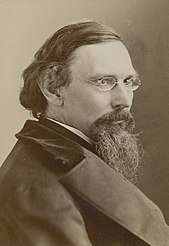George Inness
George Inness (May 1, 1825 – August 3, 1894) was a prominent American landscape painter.
George Inness | |
|---|---|
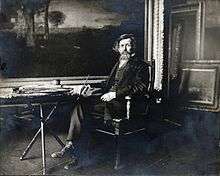 George Inness, 1890 | |
| Born | May 1, 1825 Newburgh, New York |
| Died | August 3, 1894 (aged 69) |
| Nationality | American |
| Education | Barbizon school of France |
| Known for | Landscape art, Painting |
| Movement | Hudson River School |
One of the most influential American artists of the nineteenth century, Inness was influenced, in turn, by the Old Masters, the Hudson River school, the Barbizon school, and, finally, the theology of Emanuel Swedenborg, whose spiritualism found vivid expression in the work of Inness's maturity (1879–1894).
Although Inness’s style evolved through distinct stages over a prolific career that spanned more than forty years and 1,000 paintings, his works consistently earned acclaim for their powerful, coordinated efforts to elicit depth of mood, atmosphere, and emotion. Neither pure realist nor impressionist, Inness was a transitional figure who intended for his works to combine both the earthly and the ethereal in order to capture the complete essence of a locale. A master of light, color, and shadow, he became noted for creating highly ordered and complex scenes that often juxtaposed hazy or blurred elements with sharp and refined details to evoke an interweaving of both the physical and the spiritual nature of experience. In Inness’s words, he attempted through his art to demonstrate the "reality of the unseen”[1] and to connect the "visible upon the invisible."[2]
Within his own lifetime, art critics hailed Inness as one of America's greatest artists.[3] Often called "the father of American landscape painting,"[4][5][6] Inness is best known for his mature works that not only exemplified the Tonalist movement but also displayed an original and uniquely American style.
Youth
George Inness was born in Newburgh, New York.[7] He was the fifth of thirteen children born to John William Inness, a farmer, and his wife, Clarissa Baldwin. His family moved to Newark, New Jersey when he was about five years of age.[8] In 1839 he studied for several months with an itinerant painter, John Jesse Barker.[7] In his teens, Inness worked as a map engraver in New York City. During this time he attracted the attention of French landscape painter Régis François Gignoux, with whom he subsequently studied.[7] Throughout the mid-1840s he also attended classes at the National Academy of Design, and studied the work of Hudson River School artists Thomas Cole and Asher Durand; "If," Inness later recalled thinking, "these two can be combined, I will try."[9] He debuted his work at the National Academy in 1844.[7]
Inness opened his first studio in New York in 1848.[7] In 1849, he married Delia Miller, who died a few months later. The next year he married Elizabeth Abigail Hart, with whom he would have six children.[10]
Early career
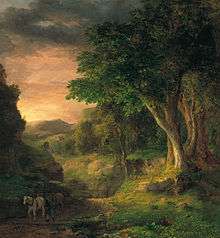

In 1851 a patron named Ogden Haggerty sponsored Inness' first trip to Europe to paint and study. Inness spent fifteen months in Rome, where he studied landscapes by Claude Lorrain and Nicolas Poussin.[7] He also rented a studio there above that of painter William Page, who likely introduced the artist to Swedenborgianism. In 1853 he was elected into the National Academy of Design as an Associate member and became a full Academician in 1868.
During trips to Paris in the early 1850s, Inness came under the influence of artists working in the Barbizon school of France. Barbizon landscapes were noted for their looser brushwork, darker palette, and emphasis on mood. Inness quickly became the leading American exponent of Barbizon-style painting, which he developed into a highly personal style. In 1854 his son George Inness, Jr., who also became a landscape painter of note, was born in Paris.
In the mid-1850s, Inness was commissioned by the Delaware, Lackawanna and Western Railroad to create paintings which documented the progress of DLWRR's growth in early Industrial America. The Lackawanna Valley, painted c. 1855, represents the railroad's first roundhouse at Scranton, Pennsylvania,[11] and integrates technology and wilderness within an observed landscape; in time, not only would Inness shun the industrial presence in favor of bucolic or agrarian subjects, but he would produce much of his mature work in the studio, drawing on his visual memory to produce scenes that were often inspired by specific places, yet increasingly concerned with formal considerations.[12]
Mid-career
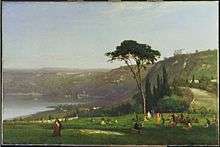
Inness moved from New York City to Medfield, Massachusetts in 1860, where he converted a barn into a studio. In 1862–63, he was an art teacher to Charles Dormon Robinson.[13] He then moved to Eagleswood, New Jersey in 1864.[7] (See George Inness House.) He returned to Europe in the spring of 1870, living in Rome and touring Tivoli, Lake Albano, and Venice.[7] In 1878, he returned to New York, taking a studio in the New York University Building.[7] The same year, he also participated in the Universal Exposition in Paris, and published art criticism in the New York Evening Post and Harper's New Monthly Magazine.[7]
His work of the 1860s and 1870s often tended toward the panoramic and picturesque, topped by cloud-laden and threatening skies, and included views of his native country (Autumn Oaks, 1878, Metropolitan Museum of Art;[14] Catskill Mountains, 1870, Art Institute of Chicago), as well as scenes inspired by numerous travels overseas, especially to Italy and France (The Monk, 1873, Addison Gallery of American Art;[15] Etretat, 1875, Wadsworth Atheneum). In terms of composition, precision of drawing, and the emotive use of color, these paintings placed Inness among the best and most successful landscape painters in America.[16]
Inness built a home and studio at Tarpon Springs, Florida in 1877. He ignored the characteristic palm and painted the drab pine woods. His painting Early Morning – Tarpon Springs depicts this environment.[17]
Eventually Inness' art evidenced the influence of the theology of Emanuel Swedenborg. Of particular interest to Inness was the notion that everything in nature had a correspondential relationship with something spiritual and so received an "influx" from God in order to continually exist. Another influence upon Inness' thinking was William James, also an adherent to Swedenborgianism. In particular, Inness was inspired by James' idea of consciousness as a "stream of thought", as well as his ideas concerning how mystical experience shapes one's perspective toward nature.[18]
Inness was the subject of a major retrospective in 1884, organized by the American Art Association, which brought him acclaim in the United States.[7] He earned international fame when he received a gold medal at the 1889 Paris Exposition.[7]
Late career


After Inness settled in Montclair, New Jersey in 1885,[19] and particularly in the last decade of his life, this mystical component manifested in his art through a more abstracted handling of shapes, softened edges, and saturated color (October, 1886, Los Angeles County Museum of Art), a profound and dramatic juxtaposition of sky and earth (Early Autumn, Montclair, 1888, Montclair Art Museum),[20] an emphasis on the intimate landscape view (Sunset in the Woods, 1891, Corcoran Gallery of Art), and an increasingly personal, spontaneous, and often violent handling of paint.[21][22] It is this last quality in particular which distinguishes Inness from those painters of like sympathies who are characterized as Luminists.[23]
In a published interview, Inness maintained that "The true use of art is, first, to cultivate the artist's own spiritual nature."[24] His abiding interest in spiritual and emotional considerations did not preclude Inness from undertaking a scientific study of color,[25] nor a mathematical,[26] structural approach to composition: "The poetic quality is not obtained by eschewing any truths of fact or of Nature...Poetry is the vision of reality."[27]
Inness died in 1894 at Bridge of Allan in Scotland.[7] According to his son, he was viewing the sunset, when he threw up his hands into the air and exclaimed, "My God! oh, how beautiful!", fell to the ground, and died minutes later.[28] A public funeral for Inness was held at the National Academy of Design, and a memorial exhibition was conducted at the Fine Arts Building in New York City.[7]
Gallery
 Milton, New York, charcoal, white wash, and gouache over graphite on grey paper, c. 1856. Yale University Art Gallery
Milton, New York, charcoal, white wash, and gouache over graphite on grey paper, c. 1856. Yale University Art Gallery Lake Nemi, oil on canvas, 1857. Yale University Art Gallery
Lake Nemi, oil on canvas, 1857. Yale University Art Gallery In the Adirondacks, oil on canvas, c. 1862. Yale University Art Gallery
In the Adirondacks, oil on canvas, c. 1862. Yale University Art Gallery The Valley of the Olives, oil on canvas, 1867. The Walters Art Museum
The Valley of the Olives, oil on canvas, 1867. The Walters Art Museum In the Roman Campagna, oil on canvas, 1873, Saint Louis Art Museum
In the Roman Campagna, oil on canvas, 1873, Saint Louis Art Museum Étretat, oil on canvas, 1875. Wadsworth Atheneum
Étretat, oil on canvas, 1875. Wadsworth Atheneum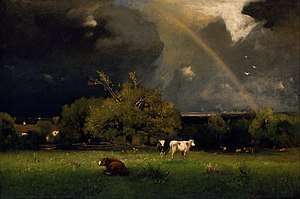 The Rainbow, oil on canvas c. 1878, Indianapolis Museum of Art
The Rainbow, oil on canvas c. 1878, Indianapolis Museum of Art Two Sisters in the Garden, oil on millboard, 1882. Art Institute of Chicago
Two Sisters in the Garden, oil on millboard, 1882. Art Institute of Chicago Frosty Morning, Montclair, oil on canvas, 1885.
Frosty Morning, Montclair, oil on canvas, 1885. Moonrise, oil on canvas, 1887. Yale University Art Gallery
Moonrise, oil on canvas, 1887. Yale University Art Gallery The Mill Stream, Montclair, New Jersey, c. 1888, Minneapolis Institute of Art
The Mill Stream, Montclair, New Jersey, c. 1888, Minneapolis Institute of Art Sunset on the Passaic, oil on canvas, 1891, Honolulu Museum of Art
Sunset on the Passaic, oil on canvas, 1891, Honolulu Museum of Art Edge of the Forest, oil on canvas, 1891. Yale University Art Gallery
Edge of the Forest, oil on canvas, 1891. Yale University Art Gallery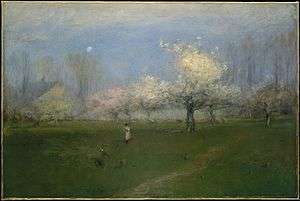 Spring Blossoms, Montclair, New Jersey, Oil and crayon or charcoal on canvas,c.1891
Spring Blossoms, Montclair, New Jersey, Oil and crayon or charcoal on canvas,c.1891 Early Morning, Tarpon Springs oil painting, 1892
Early Morning, Tarpon Springs oil painting, 1892 The Home of the Heron, 1893
The Home of the Heron, 1893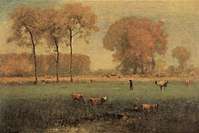 Summer Landscape, 1894
Summer Landscape, 1894.jpg) Pool in the Woods, oil painting
Pool in the Woods, oil painting June, Brooklyn Museum
June, Brooklyn Museum Sunrise, Brooklyn Museum
Sunrise, Brooklyn Museum On the Delaware River, Brooklyn Museum
On the Delaware River, Brooklyn Museum Sunset over the Sea, Brooklyn Museum
Sunset over the Sea, Brooklyn Museum Evening at Medfield, Massachusetts, 1875, Metropolitan Museum of Art
Evening at Medfield, Massachusetts, 1875, Metropolitan Museum of Art
Works
References
- Bell, Adrienne Baxter (2006). George Inness: Writings and Reflections on Art and Philosophy. New York: George Braziller. p. 79.
- "George Inness – Lines and Colors".
- Bell, Adrienne Baxter (2006). George Inness: Writings and Reflections on Art and Philosophy. New York: George Braziller. pp. 7–10.
- "George Inness, the Famous American Tonalist Painter". Retrieved July 9, 2012.
- "George Inness: Private Treasures". Montclair Art Museum. Archived from the original on April 16, 2012. Retrieved July 9, 2012.
- "MAM and Adult School of Montclair – George Inness After Hours Tour". The Jersey Tomato Press. Archived from the original on February 3, 2013. Retrieved July 9, 2012.
- Roberts, Norma J., ed. (1988), The American Collections, Columbus Museum of Art, p. 6, ISBN 0-8109-1811-0
- Bell, Adrienne Baxter (2003), George Inness and the Visionary Landscape, George Braziller, Inc., p. 151, ISBN 0-8076-1525-0
- Bell 2003, p. 151.
- Bell 2003, p. 152.
- Cikovsky, Nicolai: George Inness, p. 74. Harper & Row, Publishers, Inc., 1985. In Cikovsky's estimation, " This painting is undoubtably not only the finest of Inness' early paintings; it is also one of the finest he ever painted."
- Cikovsky, p. 154, 1985.
- Harper, Franklin (1913). Who's who on the Pacific Coast: a biographical compilation of notable living contemporaries west of the Rocky Mountains (Public domain ed.). Harper Pub. Co. pp. 483–. Retrieved January 29, 2012.
- Archived March 16, 2008, at the Wayback Machine
- http://www.the-athenaeum.org/art/display_image.php?id=49748
- In 1899, several years after Inness' death, a small landscape, Gray, Lowery Day, 1877, sold for over $10,000. Cikovsky, p. 142, 1985.
- Federal Writers' Project (1939), Florida. A Guide to the Southernmost State, New York: Oxford University Press, p. 158
- Taylor, E. I. The Interior Landscape: William James and George Inness on Art from a Swedenborgian Point of View, Archives of American Art Journal (Smithsonian Institution), 1997. 1-2, 2–10.
- "Montclair Art Museum Gallery Will Be Dedicated to Works by George Inness", Montclair Art Museum. Accessed June 4, 2008. "George Inness settled in Montclair, New Jersey in 1885, living and working there until his death in 1894."
- http://www.the-athenaeum.org/art/display_image.php?id=16685
- "The energy of his attack upon a canvas (in this case it was literally an attack), the rapidity and accuracy of his drawing and brushwork and the amount of space he would cover in a few moments, was simply marvelous to watch". Account of Arthur Turnbull Hill, Bell 2003, p. 46.
- As early as 1871, in Old Aqueduct, Camapagna, Rome, his powers of suggestion are already evident, as described in this unique passage: "In this landscape painting, he used the virtuosic brushstroke not so much to represent sheep as to present to his viewers the ontological essence of sheep." Bell 2003, p. 138.
- Bell, p. 37, 2004.
- "A Painter on Painting", Harper's New Monthly Magazine 56, p. 461. February 1878.
- "You can only achieve something if you have an ambition so powerful as to forget yourself, or if you are up on the science of your art. If a man can be an eternal God when he is outside, then he is all right; if not, he must fall back on science." Cikovsky, p. 136, 1985.
- Bell, page 28, 2004.
- Cikovsky, p. 182, 1985.
- Bell, p. 64, 2004.
External links
| Wikimedia Commons has media related to George Inness. |
- George Inness. The Complete Works
- George Inness on artchive.com
- ArtCyclopedia: George Inness
- Inness on AskArt.com
- Sterling and Francine Clark Art Institute 2008 exhibition "Like Breath on Glass: Whistler, Inness, and the Art of Painting Softly."
- "Up from the Basement – To Stardom", The Wall Street Journal, Retrieved December 2, 2011
- American Paradise: The World of the Hudson River School, an exhibition catalog from The Metropolitan Museum of Art (fully available online as PDF), which contains material on Inness (see index)
- Documenting the Gilded Age: New York City Exhibitions at the Turn of the 20th Century. A New York Art Resources Consortium project. Exhibition catalogs, a biographical description, and an essay by Thomas Kirby on Inness.
